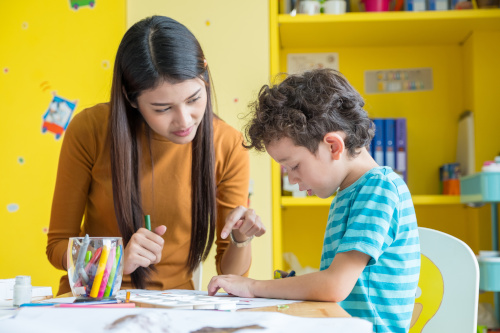Classroom-embedded PD helps teachers immediately apply and practice what they are learning directly to their classroom experiences. As they try out new skills they can receive immediate feedback, reflect on their teaching, and continuously adjust and improve their practices in real time. Expert facilitators need to have a deep understanding of each school and classroom’s unique challenges and culture and use data-based strategies to target specific needs, model evidence-based practices, and provide opportunities for hands-on work to build teachers’ skills, knowledge, and confidence.
Specialized Learning Opportunities
Special educators report on PD experiences that are overly generic and are aimed at the larger school or district environment and fail to provide them with what they need to be effective in reaching their specific goals within their own unique classrooms. Professional learning needs to be connected to the curriculum with specialized and relevant content that will serve to develop and deepen teachers’ ability to effectively implement the curriculum.
PD that focuses on strategies connected to specific curriculum content directly transfers into more effective teaching practices. Learning can drill down to focus on immediate and specific needs such as implementing data management systems and reviewing the fidelity of an implementation. Trainers can also step in and help teachers create individualized assessments, progress monitoring and progression planning as well as develop recommendations for tailoring IEP goals to align with student capacity and grade-level standards.
Ongoing Support
The majority of special education teachers report that their PD experiences were brief and typically take place during conferences. These one-off sessions present few opportunities for reflection, fail to deepen skills or pedagogical knowledge, and infringe upon the teachers’ time for planning.
Darling-Hammond and her colleagues report that the duration and intensity of professional learning has a clear and positive association with student achievement. They found that PD programs that included an average of 49 hours per year resulted in a 21 percent increase in student achievement. They emphasize that the number of hours spent and the duration of time — typically spreading out PD over the course of a school year — are crucial to seeing significant improvement in teachers’ abilities and student success.
Flexible Options Using Technology
Intentional use of technology can provide flexibility, facilitate access, and save schools and teachers time and money. Teachers andschool administrators report that they want the flexibility of virtual PD, but they also find that in-person options result in greater engagement and learning. We know that in-person training lends itself to being classroom-embedded and tied to specific curricula — all factors outlined above that result in effective outcomes. At the same time, in person is expensive, sometimes difficult to implement, and lacks the flexibility of online options.
But perhaps we can have our cake and eat it too? Webinars and videos that supplement classroom-embedded PD can serve to deepen learning. In addition, some promising new technologies can provide options that can approximate classroom-embedded PD. One example is eCoaching and BIE (Bug-in-Ear) technologies that have been shown to effectively provide performance feedback to teachers and specialists without a coach being physically present. Rural schools, in particular, could greatly benefit from this type of learning experience due to the challenges of getting trainers out to remote areas.
It is important to reduce pay disparities and create more robust recruitment strategies for special educators, but the bottom line is that if these teachers find that they don’t have the support they need to be effective in the classroom, they will continue to leave. Let’s focus on what matters most and provide them with learning opportunities that we know can help them succeed in making a difference in their students’ lives.
- Are substitutes the answer to the teacher shortage? - June 13, 2023
- Preparing for ransomware attacks begins with education - June 13, 2023
- How to use UDL-inspired technology to reengage students - June 12, 2023

